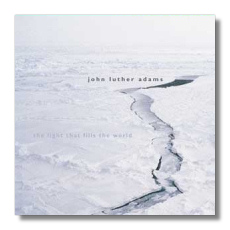
The Internet's Premier Classical Music Source
Related Links
- Latest Reviews
- More Reviews
-
By Composer
-
Collections
DVD & Blu-ray
Books
Concert Reviews
Articles/Interviews
Software
Audio
Search Amazon
Recommended Links
Site News
 CD Review
CD Review
John Luther Adams

The Light That Fills the World
- The Light That Fills the World
- The Farthest Place
- The Immeasurable Space of Tones
Marty Walker, bass clarinet
Amy Knoles, vibraphone and marimba
Bryan Pezzone, piano
Nathaniel Reichman, electric keyboard and sound design
Robin Lorentz, violin
Barry Newton, double bass
Cold Blue CB0010 DDD 50:57
Composer John Luther Adams must be tired of being called "the other John Adams." (He's also known as "the Alaskan John Adams," as he has lived outside of Fairbanks for more than twenty-five years.) In the press kit for this release, Adams writes, "The ideal of the sublime landscape has long been an obsessive metaphor for my work." He describes his more recent works as having become increasingly introverted, and "there are no lines left – only slowly changing light on a timeless field […. ] Harmony and color become one with space and time."
The three works on this CD date from 1998-2001. (That's about all Cold Blue cares to tell us in their booklet, so thank goodness for press kits!) Apparently scored for the same combination of instruments, they explore variations on the same theme: how can one evoke change and stasis at the same time? Seat yourself in front of a river or look up at a sky filled with cumulus clouds and it's easy to experience this, but it's more difficult to create the same effect through music.
It isn't necessary to listen to Adams's music as much as it is to inhabit it, to press against its fuzzy outlines and to let its tendrils move through and around you. If the Museum of Jurassic Technology is ever looking for its Pictures at an Exhibition, it might find it in the works on this CD. One's perception of the music changes with time and distance. Are there no details? Are there an infinite number of details? Is it moving very quickly or very slowly? Adams speaks of "a sort of polyphony of harmonic clouds," which seems like a perfect description until one reads that not even the composer has been sure at all times about whether this new music is experienced as homogeneity or heterogeneity. You won't hear bar lines here, nor will you hear melodies as most people understand them. The instrumental parts develop independently; drones lead to tremolos, and tremolos give way to oscillations. At times, one's ear isolates individual parts, but the entire sonic stew is what is important here. Points of reference include Eno and Ligeti, and also Henry Cowell, whose simultaneous subdivision of the measure into different parts informs Adams's work. This is true for all three works on this CD. They differ in complexity and in harmonic palette, but they are essentially three different representations of the same idea.
Because the composer is this CD's co-producer, I assume the performances accurately reflect his intentions. Make sure the contents of your china cabinet are secure before putting this one on; the bass notes pack a punch!
Copyright © 2003, Raymond Tuttle




















